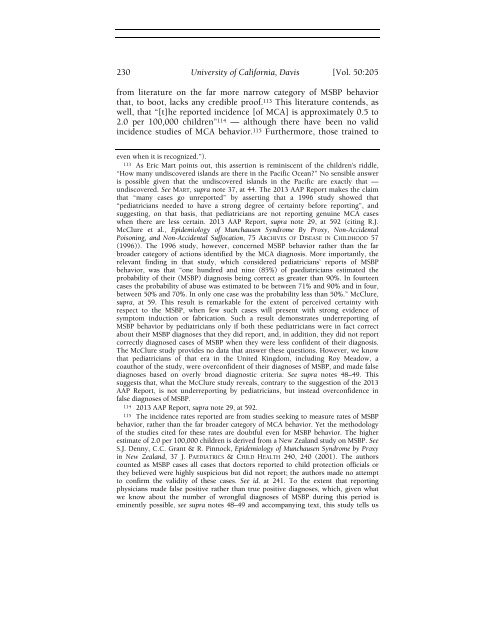Bad Medicine Parents the State and the Charge of “Medical Child Abuse”
URLsZzFO
URLsZzFO
You also want an ePaper? Increase the reach of your titles
YUMPU automatically turns print PDFs into web optimized ePapers that Google loves.
230 University <strong>of</strong> California, Davis [Vol. 50:205<br />
from literature on <strong>the</strong> far more narrow category <strong>of</strong> MSBP behavior<br />
that, to boot, lacks any credible pro<strong>of</strong>. 113 This literature contends, as<br />
well, that “[t]he reported incidence [<strong>of</strong> MCA] is approximately 0.5 to<br />
2.0 per 100,000 children” 114 — although <strong>the</strong>re have been no valid<br />
incidence studies <strong>of</strong> MCA behavior. 115 Fur<strong>the</strong>rmore, those trained to<br />
even when it is recognized.”).<br />
113 As Eric Mart points out, this assertion is reminiscent <strong>of</strong> <strong>the</strong> children’s riddle,<br />
“How many undiscovered isl<strong>and</strong>s are <strong>the</strong>re in <strong>the</strong> Pacific Ocean?” No sensible answer<br />
is possible given that <strong>the</strong> undiscovered isl<strong>and</strong>s in <strong>the</strong> Pacific are exactly that —<br />
undiscovered. See MART, supra note 37, at 44. The 2013 AAP Report makes <strong>the</strong> claim<br />
that “many cases go unreported” by asserting that a 1996 study showed that<br />
“pediatricians needed to have a strong degree <strong>of</strong> certainty before reporting”, <strong>and</strong><br />
suggesting, on that basis, that pediatricians are not reporting genuine MCA cases<br />
when <strong>the</strong>re are less certain. 2013 AAP Report, supra note 29, at 592 (citing R.J.<br />
McClure et al., Epidemiology <strong>of</strong> Munchausen Syndrome By Proxy, Non-Accidental<br />
Poisoning, <strong>and</strong> Non-Accidental Suffocation, 75 ARCHIVES OF DISEASE IN CHILDHOOD 57<br />
(1996)). The 1996 study, however, concerned MSBP behavior ra<strong>the</strong>r than <strong>the</strong> far<br />
broader category <strong>of</strong> actions identified by <strong>the</strong> MCA diagnosis. More importantly, <strong>the</strong><br />
relevant finding in that study, which considered pediatricians’ reports <strong>of</strong> MSBP<br />
behavior, was that “one hundred <strong>and</strong> nine (85%) <strong>of</strong> paediatricians estimated <strong>the</strong><br />
probability <strong>of</strong> <strong>the</strong>ir (MSBP) diagnosis being correct as greater than 90%. In fourteen<br />
cases <strong>the</strong> probability <strong>of</strong> abuse was estimated to be between 71% <strong>and</strong> 90% <strong>and</strong> in four,<br />
between 50% <strong>and</strong> 70%. In only one case was <strong>the</strong> probability less than 50%.” McClure,<br />
supra, at 59. This result is remarkable for <strong>the</strong> extent <strong>of</strong> perceived certainty with<br />
respect to <strong>the</strong> MSBP, when few such cases will present with strong evidence <strong>of</strong><br />
symptom induction or fabrication. Such a result demonstrates underreporting <strong>of</strong><br />
MSBP behavior by pediatricians only if both <strong>the</strong>se pediatricians were in fact correct<br />
about <strong>the</strong>ir MSBP diagnoses that <strong>the</strong>y did report, <strong>and</strong>, in addition, <strong>the</strong>y did not report<br />
correctly diagnosed cases <strong>of</strong> MSBP when <strong>the</strong>y were less confident <strong>of</strong> <strong>the</strong>ir diagnosis.<br />
The McClure study provides no data that answer <strong>the</strong>se questions. However, we know<br />
that pediatricians <strong>of</strong> that era in <strong>the</strong> United Kingdom, including Roy Meadow, a<br />
coauthor <strong>of</strong> <strong>the</strong> study, were overconfident <strong>of</strong> <strong>the</strong>ir diagnoses <strong>of</strong> MSBP, <strong>and</strong> made false<br />
diagnoses based on overly broad diagnostic criteria. See supra notes 48–49. This<br />
suggests that, what <strong>the</strong> McClure study reveals, contrary to <strong>the</strong> suggestion <strong>of</strong> <strong>the</strong> 2013<br />
AAP Report, is not underreporting by pediatricians, but instead overconfidence in<br />
false diagnoses <strong>of</strong> MSBP.<br />
114 2013 AAP Report, supra note 29, at 592.<br />
115 The incidence rates reported are from studies seeking to measure rates <strong>of</strong> MSBP<br />
behavior, ra<strong>the</strong>r than <strong>the</strong> far broader category <strong>of</strong> MCA behavior. Yet <strong>the</strong> methodology<br />
<strong>of</strong> <strong>the</strong> studies cited for <strong>the</strong>se rates are doubtful even for MSBP behavior. The higher<br />
estimate <strong>of</strong> 2.0 per 100,000 children is derived from a New Zeal<strong>and</strong> study on MSBP. See<br />
S.J. Denny, C.C. Grant & R. Pinnock, Epidemiology <strong>of</strong> Munchausen Syndrome by Proxy<br />
in New Zeal<strong>and</strong>, 37 J. PAEDIATRICS & CHILD HEALTH 240, 240 (2001). The authors<br />
counted as MSBP cases all cases that doctors reported to child protection <strong>of</strong>ficials or<br />
<strong>the</strong>y believed were highly suspicious but did not report; <strong>the</strong> authors made no attempt<br />
to confirm <strong>the</strong> validity <strong>of</strong> <strong>the</strong>se cases. See id. at 241. To <strong>the</strong> extent that reporting<br />
physicians made false positive ra<strong>the</strong>r than true positive diagnoses, which, given what<br />
we know about <strong>the</strong> number <strong>of</strong> wrongful diagnoses <strong>of</strong> MSBP during this period is<br />
eminently possible, see supra notes 48–49 <strong>and</strong> accompanying text, this study tells us


